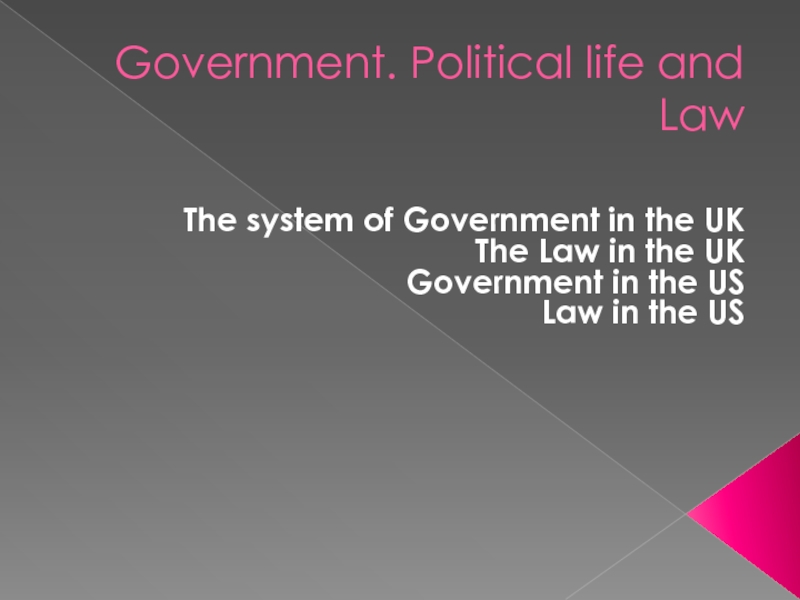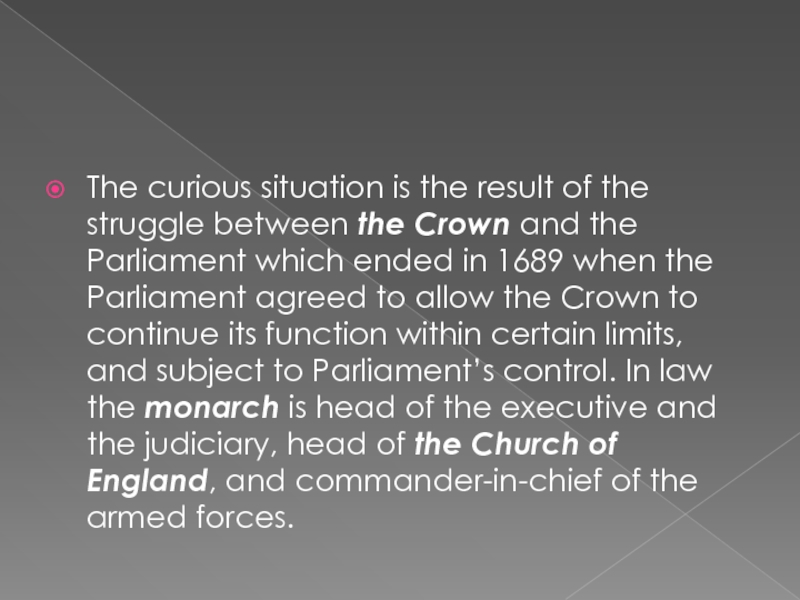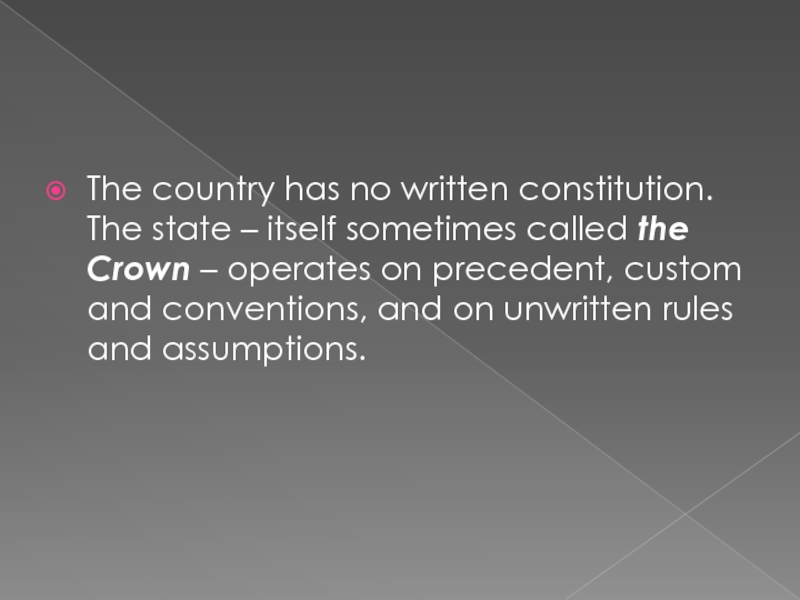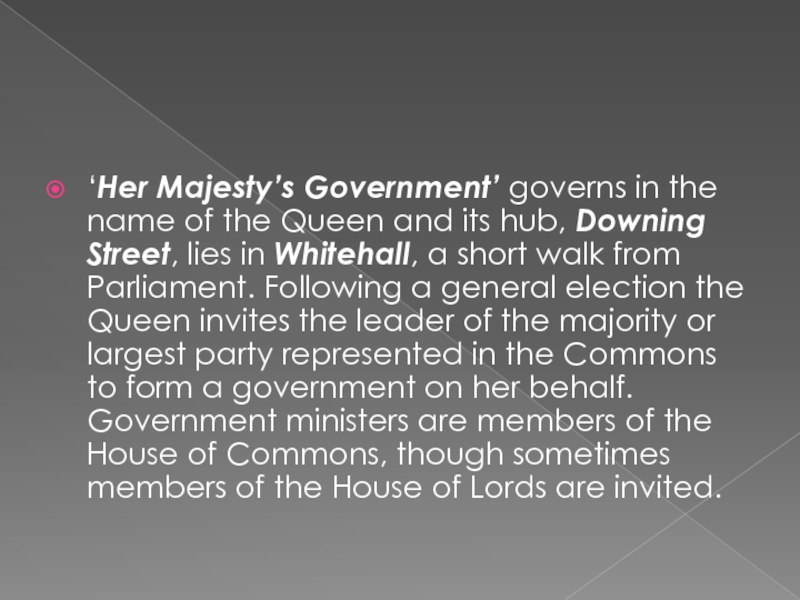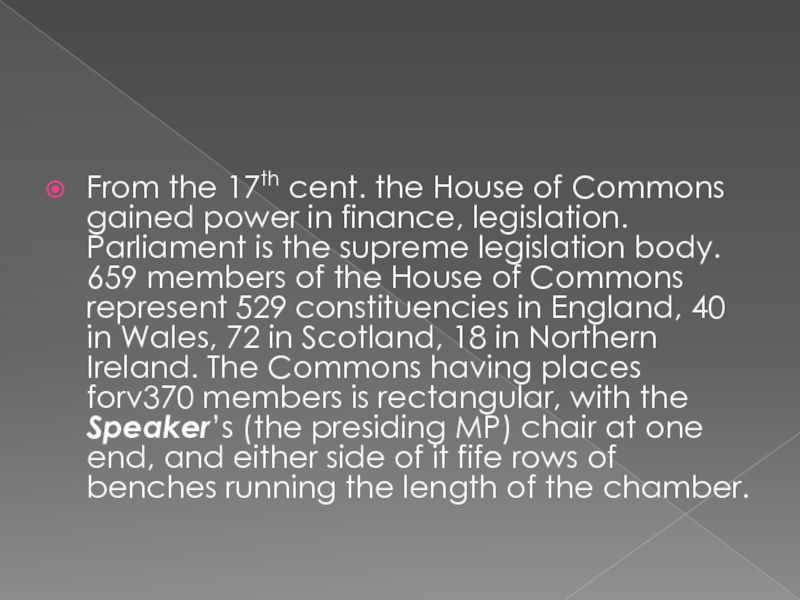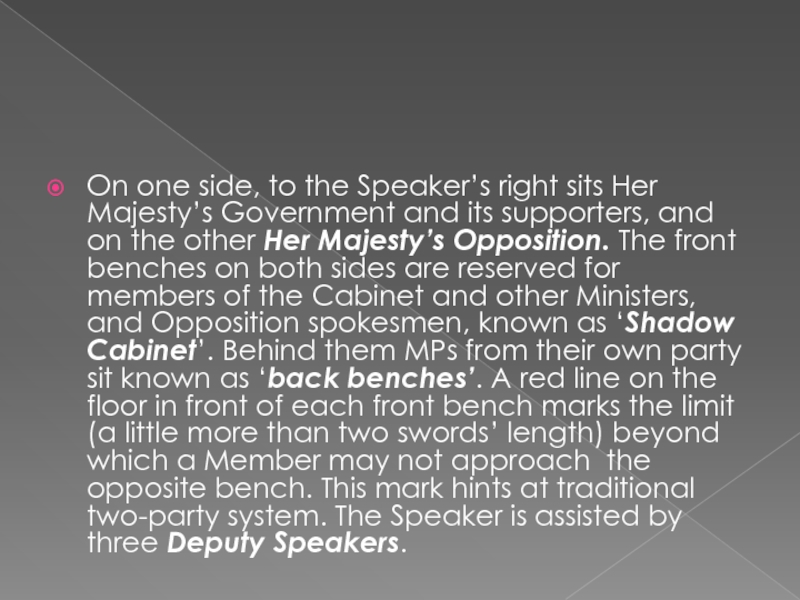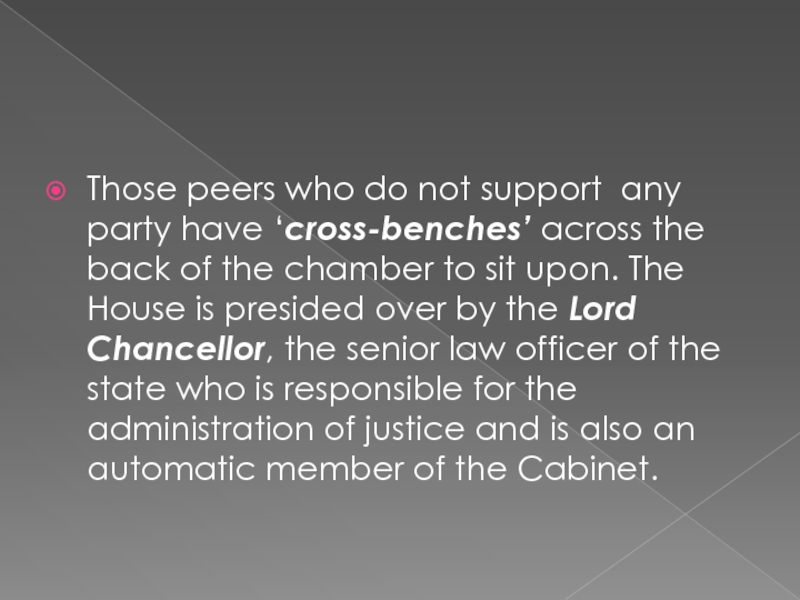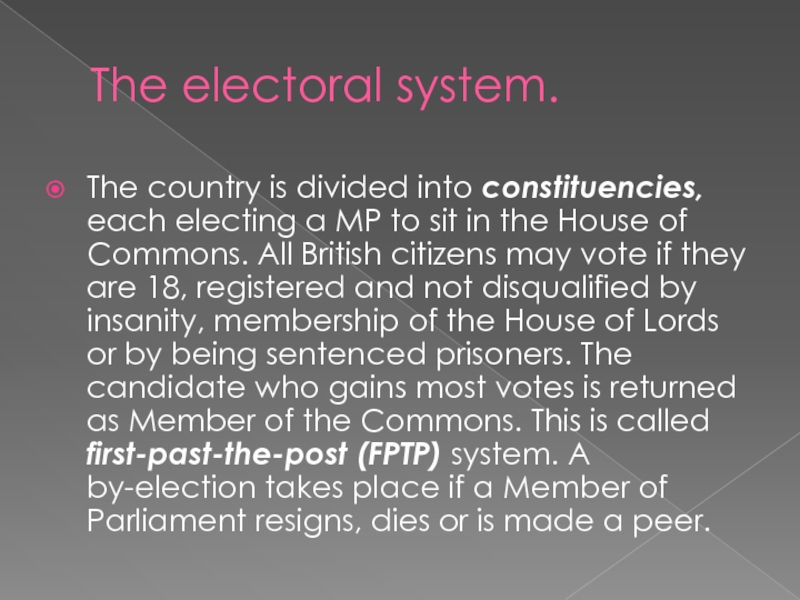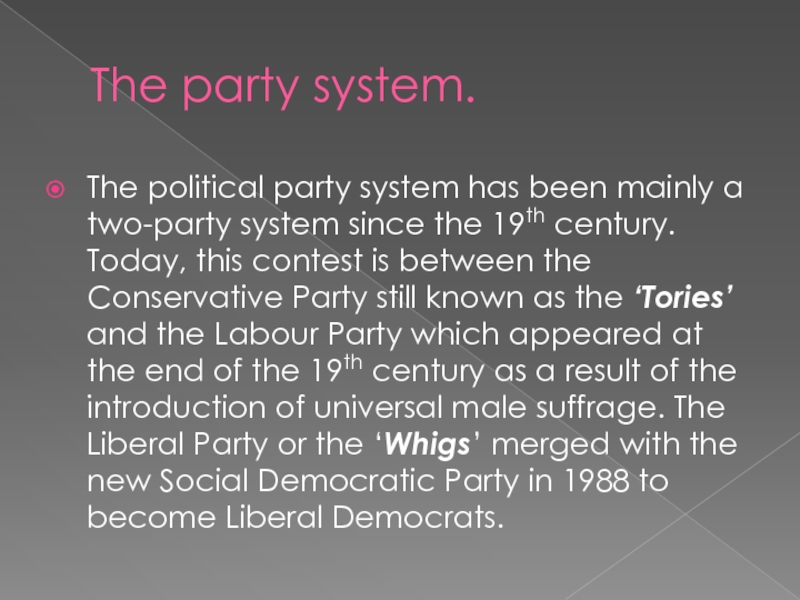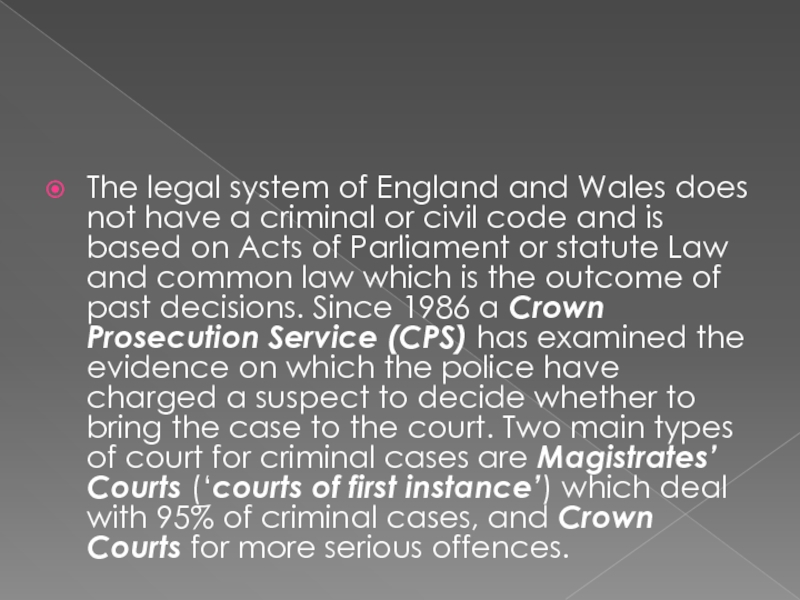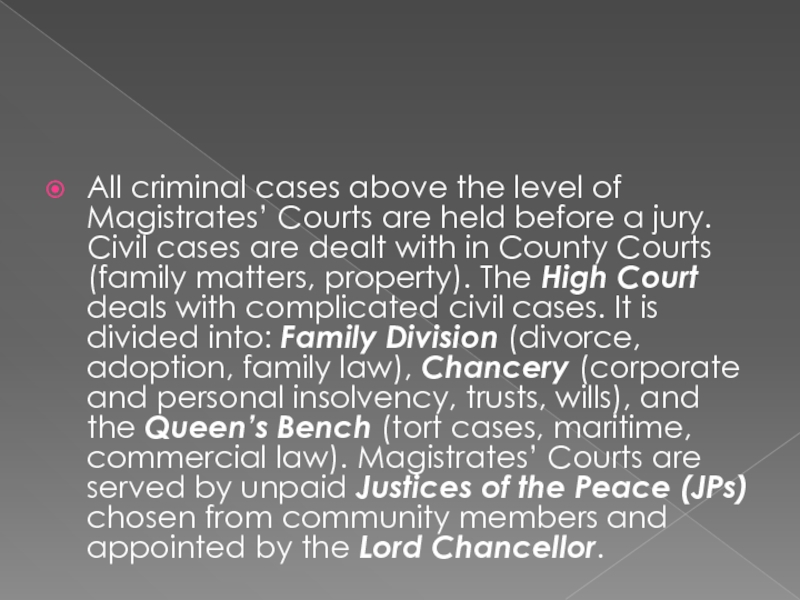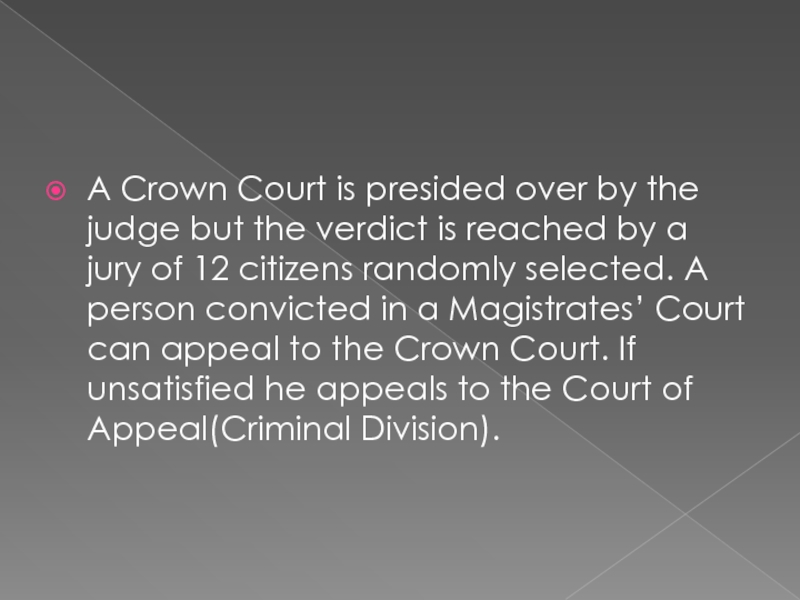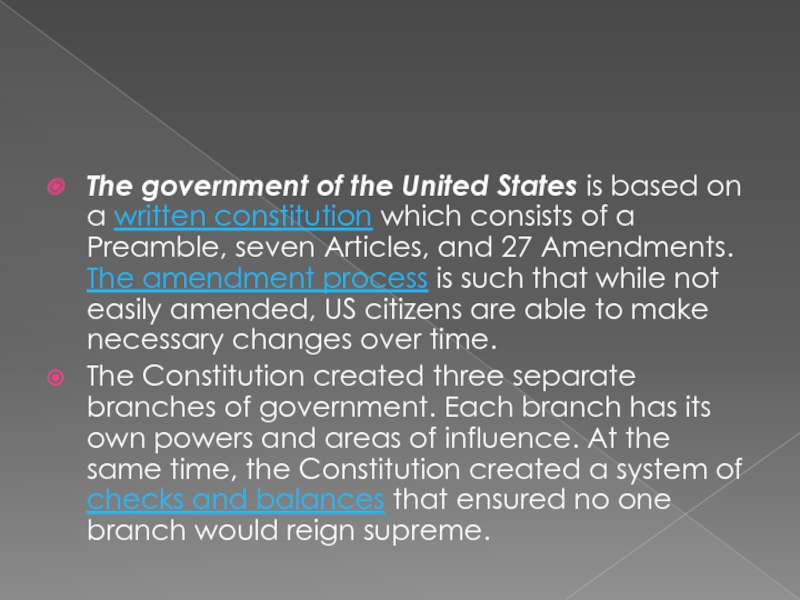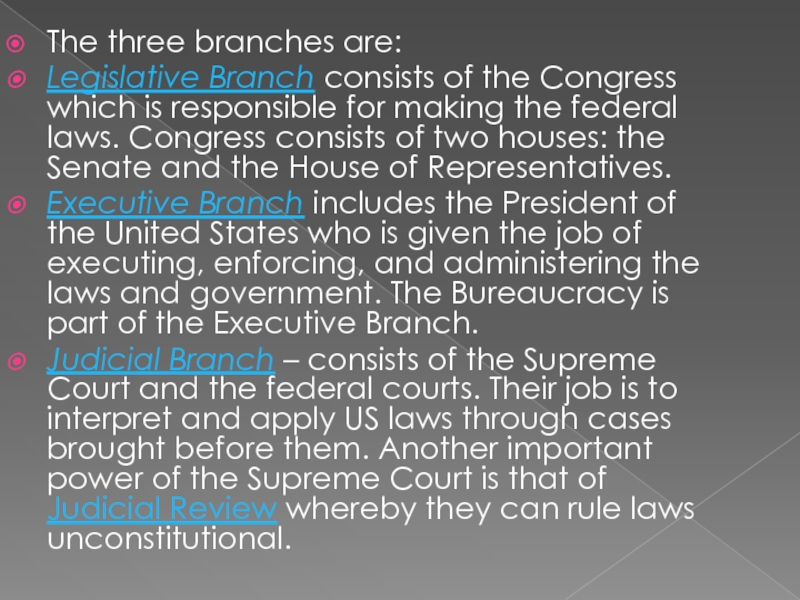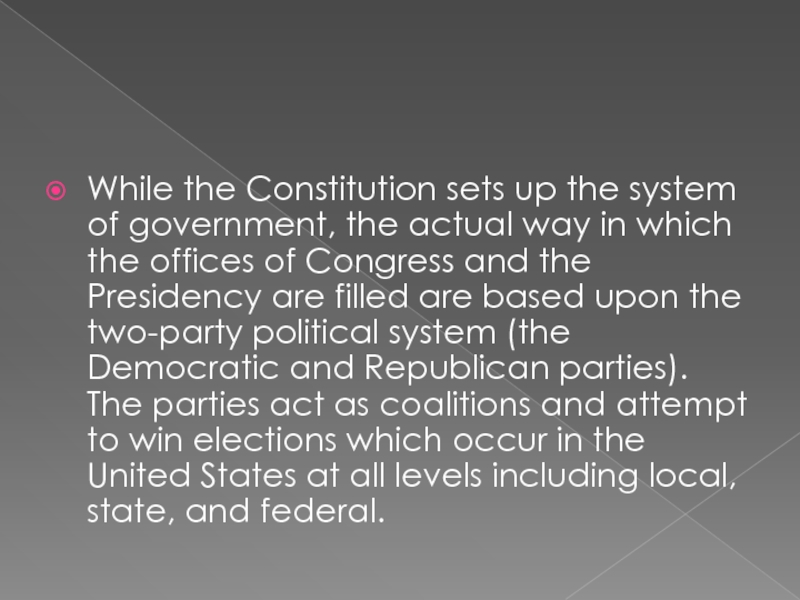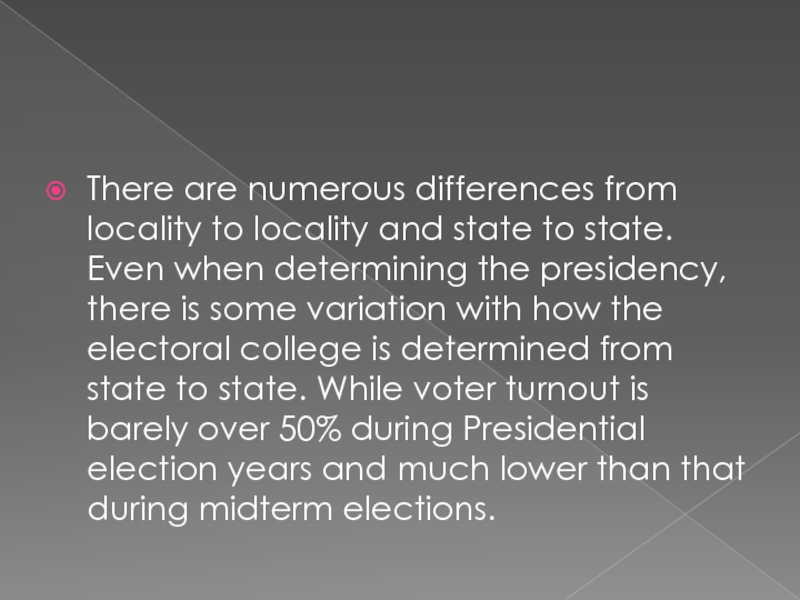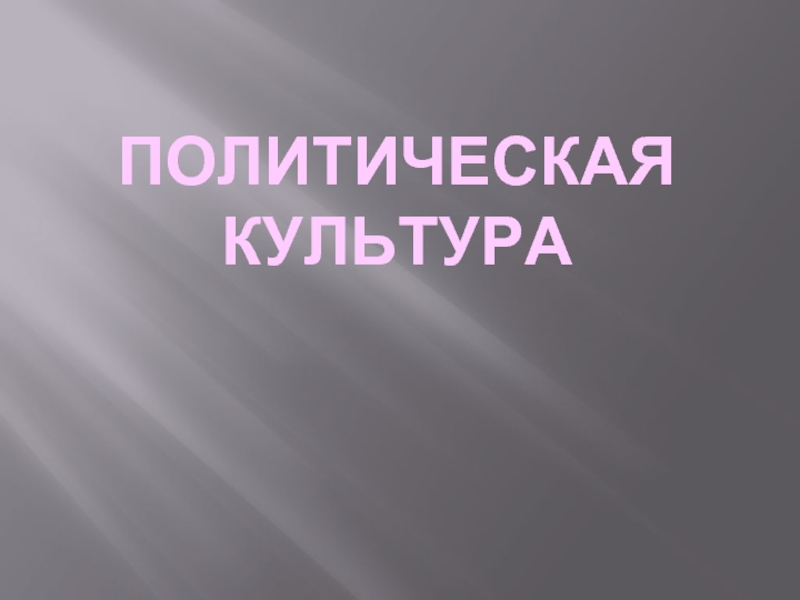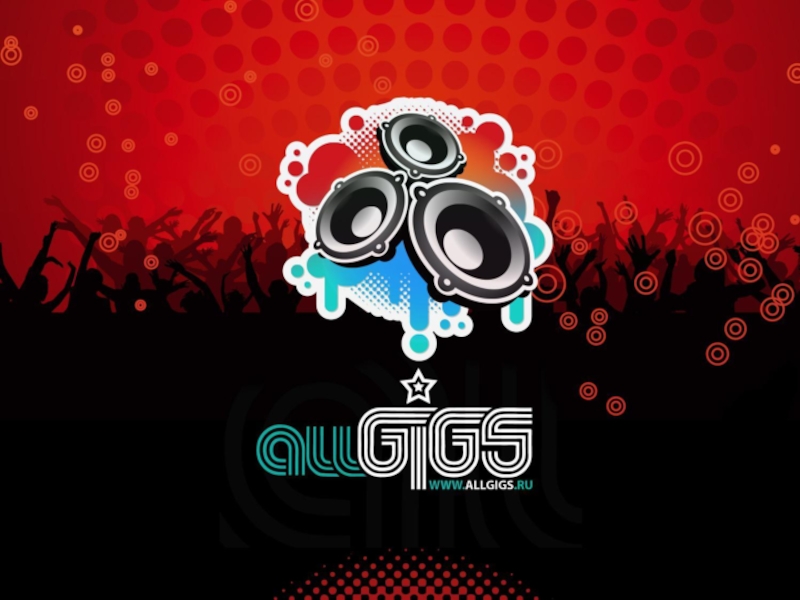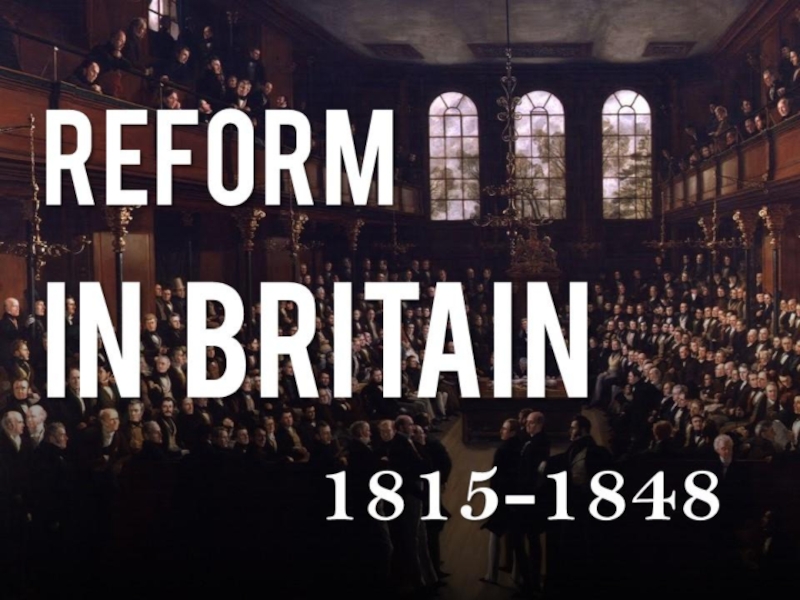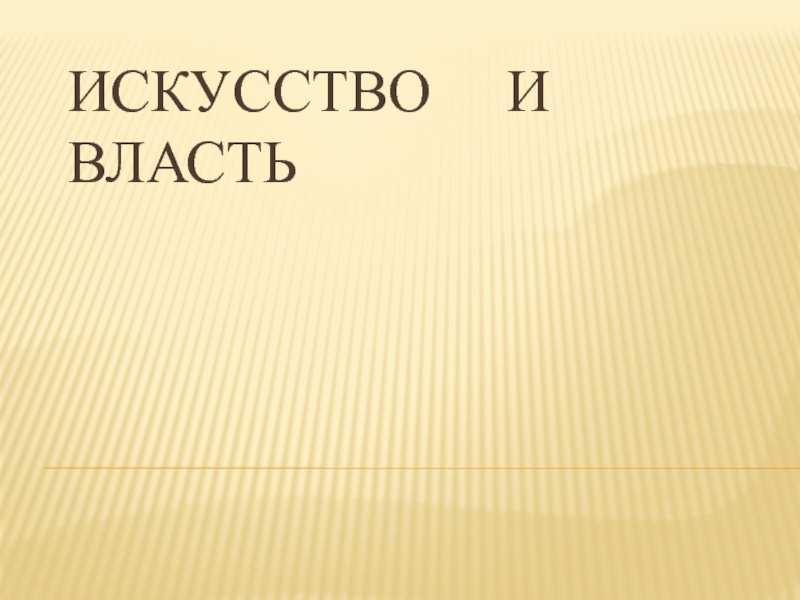Law in the UK
Government in the US
Law in the US
- Главная
- Разное
- Дизайн
- Бизнес и предпринимательство
- Аналитика
- Образование
- Развлечения
- Красота и здоровье
- Финансы
- Государство
- Путешествия
- Спорт
- Недвижимость
- Армия
- Графика
- Культурология
- Еда и кулинария
- Лингвистика
- Английский язык
- Астрономия
- Алгебра
- Биология
- География
- Детские презентации
- Информатика
- История
- Литература
- Маркетинг
- Математика
- Медицина
- Менеджмент
- Музыка
- МХК
- Немецкий язык
- ОБЖ
- Обществознание
- Окружающий мир
- Педагогика
- Русский язык
- Технология
- Физика
- Философия
- Химия
- Шаблоны, картинки для презентаций
- Экология
- Экономика
- Юриспруденция
Government. Political life and law презентация
Содержание
- 1. Government. Political life and law
- 2. Great Britain is a democracy in
- 3. The curious situation is the result
- 4. The country has no written constitution.
- 5. ‘Her Majesty’s Government’ governs in the
- 6. Ministers, the Prime Minister included, continue
- 7. The civil servants wishing to stand
- 8. Parliament. Her Majesty’s Government derives its authorities
- 9. From the 17th cent. the House
- 10. On one side, to the Speaker’s
- 11. The upper chamber consists of four
- 12. Those peers who do not support
- 13. The electoral system. The country is divided
- 14. The party system. The political party
- 15. The legal system of England and
- 16. All criminal cases above the level
- 17. A Crown Court is presided over
- 18. Traditionally legal profession is divided into two
- 19. The government of the United States
- 20. The three branches are: Legislative Branch consists
- 21. While the Constitution sets up the
- 22. There are numerous differences from locality
Слайд 2
Great Britain is a democracy in which the constitutional situation is
a contradictory one. The people of Britain are subjects of the Queen. Yet the Queen receives her authority from the parliament, she reigns but does not rule. Technically British sovereignty resides in the three elements of Parliament: the Crown, and Parliament’s two chambers, the House of Lords and the House of Commons.
Слайд 3
The curious situation is the result of the struggle between the
Crown and the Parliament which ended in 1689 when the Parliament agreed to allow the Crown to continue its function within certain limits, and subject to Parliament’s control. In law the monarch is head of the executive and the judiciary, head of the Church of England, and commander-in-chief of the armed forces.
Слайд 4
The country has no written constitution. The state – itself sometimes
called the Crown – operates on precedent, custom and conventions, and on unwritten rules and assumptions.
Слайд 5
‘Her Majesty’s Government’ governs in the name of the Queen and
its hub, Downing Street, lies in Whitehall, a short walk from Parliament. Following a general election the Queen invites the leader of the majority or largest party represented in the Commons to form a government on her behalf. Government ministers are members of the House of Commons, though sometimes members of the House of Lords are invited.
Слайд 6
Ministers, the Prime Minister included, continue to represent the parliamentary constituencies
which elected them. Government consists of about 100 members, 20 or so of most senior ministers comprise the Cabinet – the essential core. Government being essentially political depends on a permanent body of officials, the Civil Service which administers the decisions of the Government. The Civil Service employs 500,000 people and is expected to discharge its responsibilities in a politically impartial way.
Слайд 7
The civil servants wishing to stand for Parliament must resign first
from the Civil Service. The Cabinet Office is the heart of the Civil Service. Its Secretary who runs the Civil Service is the most senior civil servant at any given time.
Слайд 8Parliament.
Her Majesty’s Government derives its authorities from its party representation in
Parliament. While the Government is often referred to as Whitehall, Parliament dating from the 13th century is known as Westminster as it is housed in the Palace of Westminster. The House of Lords was initially created to provide a council of the nobility for the king, the Commons were summoned to provide the king with the money.
Слайд 9
From the 17th cent. the House of Commons gained power in
finance, legislation. Parliament is the supreme legislation body. 659 members of the House of Commons represent 529 constituencies in England, 40 in Wales, 72 in Scotland, 18 in Northern Ireland. The Commons having places forv370 members is rectangular, with the Speaker’s (the presiding MP) chair at one end, and either side of it fife rows of benches running the length of the chamber.
Слайд 10
On one side, to the Speaker’s right sits Her Majesty’s Government
and its supporters, and on the other Her Majesty’s Opposition. The front benches on both sides are reserved for members of the Cabinet and other Ministers, and Opposition spokesmen, known as ‘Shadow Cabinet’. Behind them MPs from their own party sit known as ‘back benches’. A red line on the floor in front of each front bench marks the limit (a little more than two swords’ length) beyond which a Member may not approach the opposite bench. This mark hints at traditional two-party system. The Speaker is assisted by three Deputy Speakers.
Слайд 11
The upper chamber consists of four categories of peer: 1,197 members
in 1996. The majority are hereditary peers (750 now). About 400 are life peers a quarter of which are women. Nine of the most senior judges, the Lords of Appeal in Ordinary (Law Lords) sit there as well. Alongside secular peers, the Lords Temporal, are the 26 most senior bishops and archbishops of the Church of England, the Lords Spiritual.
Слайд 12
Those peers who do not support any party have ‘cross-benches’ across
the back of the chamber to sit upon. The House is presided over by the Lord Chancellor, the senior law officer of the state who is responsible for the administration of justice and is also an automatic member of the Cabinet.
Слайд 13The electoral system.
The country is divided into constituencies, each electing a
MP to sit in the House of Commons. All British citizens may vote if they are 18, registered and not disqualified by insanity, membership of the House of Lords or by being sentenced prisoners. The candidate who gains most votes is returned as Member of the Commons. This is called first-past-the-post (FPTP) system. A by-election takes place if a Member of Parliament resigns, dies or is made a peer.
Слайд 14The party system.
The political party system has been mainly a
two-party system since the 19th century. Today, this contest is between the Conservative Party still known as the ‘Tories’ and the Labour Party which appeared at the end of the 19th century as a result of the introduction of universal male suffrage. The Liberal Party or the ‘Whigs’ merged with the new Social Democratic Party in 1988 to become Liberal Democrats.
Слайд 15
The legal system of England and Wales does not have a
criminal or civil code and is based on Acts of Parliament or statute Law and common law which is the outcome of past decisions. Since 1986 a Crown Prosecution Service (CPS) has examined the evidence on which the police have charged a suspect to decide whether to bring the case to the court. Two main types of court for criminal cases are Magistrates’ Courts (‘courts of first instance’) which deal with 95% of criminal cases, and Crown Courts for more serious offences.
Слайд 16
All criminal cases above the level of Magistrates’ Courts are held
before a jury. Civil cases are dealt with in County Courts (family matters, property). The High Court deals with complicated civil cases. It is divided into: Family Division (divorce, adoption, family law), Chancery (corporate and personal insolvency, trusts, wills), and the Queen’s Bench (tort cases, maritime, commercial law). Magistrates’ Courts are served by unpaid Justices of the Peace (JPs) chosen from community members and appointed by the Lord Chancellor.
Слайд 17
A Crown Court is presided over by the judge but the
verdict is reached by a jury of 12 citizens randomly selected. A person convicted in a Magistrates’ Court can appeal to the Crown Court. If unsatisfied he appeals to the Court of Appeal(Criminal Division).
Слайд 18Traditionally legal profession is divided into two practices: only solicitors deal
directly with the public, and only barristers may fight a case in the higher courts. The former are united by the Law Society, the latter are members of the Bar. Barristers are fewer in number and are the senior branch of the legal profession. To become a barrister a candidate should enter one of four Inns of Court (law colleges dating from the Middle Ages) complete the course and pass the bar examination.
Слайд 19
The government of the United States is based on a written
constitution which consists of a Preamble, seven Articles, and 27 Amendments. The amendment process is such that while not easily amended, US citizens are able to make necessary changes over time.
The Constitution created three separate branches of government. Each branch has its own powers and areas of influence. At the same time, the Constitution created a system of checks and balances that ensured no one branch would reign supreme.
The Constitution created three separate branches of government. Each branch has its own powers and areas of influence. At the same time, the Constitution created a system of checks and balances that ensured no one branch would reign supreme.
Слайд 20The three branches are:
Legislative Branch consists of the Congress which is
responsible for making the federal laws. Congress consists of two houses: the Senate and the House of Representatives.
Executive Branch includes the President of the United States who is given the job of executing, enforcing, and administering the laws and government. The Bureaucracy is part of the Executive Branch.
Judicial Branch – consists of the Supreme Court and the federal courts. Their job is to interpret and apply US laws through cases brought before them. Another important power of the Supreme Court is that of Judicial Review whereby they can rule laws unconstitutional.
Executive Branch includes the President of the United States who is given the job of executing, enforcing, and administering the laws and government. The Bureaucracy is part of the Executive Branch.
Judicial Branch – consists of the Supreme Court and the federal courts. Their job is to interpret and apply US laws through cases brought before them. Another important power of the Supreme Court is that of Judicial Review whereby they can rule laws unconstitutional.
Слайд 21
While the Constitution sets up the system of government, the actual
way in which the offices of Congress and the Presidency are filled are based upon the two-party political system (the Democratic and Republican parties). The parties act as coalitions and attempt to win elections which occur in the United States at all levels including local, state, and federal.
Слайд 22
There are numerous differences from locality to locality and state to
state. Even when determining the presidency, there is some variation with how the electoral college is determined from state to state. While voter turnout is barely over 50% during Presidential election years and much lower than that during midterm elections.
